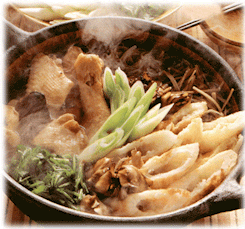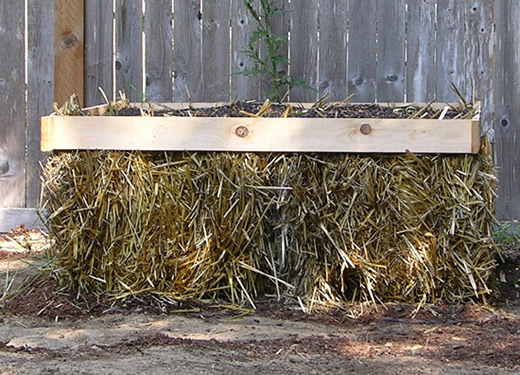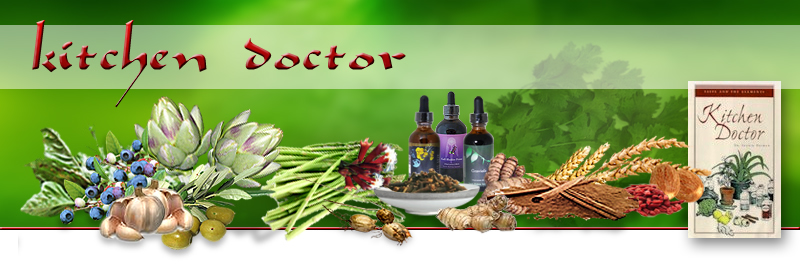|
Gobo
Burdock Root
Arctium
lappa
Burdock is the main herb in the famous Essiac formula. It was introduced as a cancer remedy by Rene Caisse but learned by her from Ojibwa herbal traditions. Interestingly, it is also a key
herb in Hildegard
of Bingen's 12th century internal tonic for cancer. It
is discussed in the appendix of my book where
I point out that it remains to this day a highly controversial
herb, prized by many as a diuretic and even as the main herb
to prevent angiogenesis, the formation of auxiliary arteries
that feed tumors. If it is effective for this, it is a reasonable
alternative to shark cartilade and the overharvesting of a
species. Others disregard the herb to such an extent that it
is omitted from some textbooks.
 |
I confess, I stole this picture from
a Japanese web
site. I hope my action will be appreciated, not scolded.
The ingredients are: soup stock, maitake
mushrooms, burdock, leeks, Japanese parsley, and konnyaku,
a gelatinous vegetable well known in Japanese cuisine. |
Burdock is a member of the daisy
family. It is native to Europe but grows almost anywhere, obviously
in the Great Lakes area where the nurse's and the Ojibwa's
paths met. The Japanese, who call burdock "gobo" eat
it as a sort of Zen austerity. The root is long and thin, sort
of like a carrot without pigmentation. It is definitely Zen
and bland tasting. The French prepare burdock like asparagus
and some people prepare it as a potato substitute in soups,
pancakes, and cutlets. It is one of the main ingredients in
most grain coffees, certainly a reason for cancer patients
who are concerned about caffeine and its effect on the pancreas
and cancer to switch to grain coffee.
Burdock is easy to grow. I had lots of it
in my garden in Cundiyo and ate the leaves and roots. It is
the first year's growth of the roots that is used both for
culinary and medicinal purposes. The root is harvested before
the purple flowers open. Herbalists, who consider burdock to
be a tumor resolvent, use burdock primarily for uterine complaints
and as a poultice to reduce swelling. The leaves, being quite
bitter, have a stronger hypoglycemic action than the roots
which are more mucilaginous.
Scientific studies in Germany (1967)
and Japan (1986) concluded that burdock has powerful antifungal
and antibacterial actions. It is such a good blood purifier
that it can even be used with venomous bites. Unlike the
Ojibwas and Caisse, most herbalists combine burdock with
yellow dock and sarsaparilla . . . in which case it would
have extremely valuable blood purifying actions. Even by
itself, it is highly regarded as the herb of choice for conditions
such as eczema.
Research on burdock is sparse but consistent.
Hungarians found anti-tumor actions and the Japanese, who truly
love this plant, have identified a desmutagen that they named
B-factor in honor of burdock. It is so powerful that it prevents
cellular mutation in the absence of as well as presence metabolic
activation.
So, we have at least 800 years of herbal medicine
supporting the use of burdock. Burdock is in the Hoxsey
formula that we have re-created . . . and I would like
to go on record saying that I personally believe this formula
to be significantly superior to Essiac, but it is also much
more concentrated than a tea could ever be.

Using hints from Richo Cech at Horizon Herbs, I planted my burdock on straw bales. There is about 3" of good soil on top of the straw. When ready to harvest, the bales will be knocked apart and the roots can be easily picked out without digging. The straw can then be used for mulch.
Burdock is about 50% inulin. It is high in potassium and is also a good source of calcium, phosphorus, and manganese as well as vitamins C and K. It can be harvested as early as 20 weeks after planting. Both the roots and leaves are edible, but the leaves are very bitter whereas the root is somewhat bland tasting and bit mucilaginous. It is this property that enables burdock to bind with toxins and remove them from the body.
Obviously, regular use and long-term use confer more benefits than sporadic adventures with exotic recipes. Being bland, the root can be added to stir fries, casseroles, and even pancakes or muffins without throwing off the intended flavor of the dish. The root can be boiled, baked, roasted, or fried but if marinated, it is more interesting tasting. I have also included burdock in biscuits that I made for a horse and my dogs.
Finally, if you want to go Oriental, think of tempura, sukiyaki, shabu shabu, chawanmushi, or any recipe with carrots because though lacking the bright color, gobo is a perfect substitute for carrots in just about any recipe. Gobo is a popular food in Japan where it is viewed as a sort of culinary ginseng with significant medicinal benefits.
Warning: large amounts are not recommended for pregnant women because burdock is a uterine stimulant.
|




